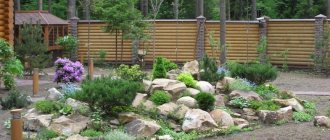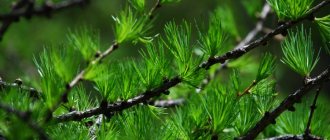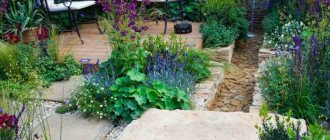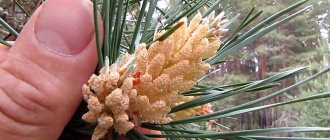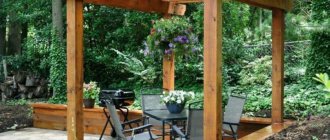The time when you could plant daffodils on your property, fence them with bricks and be satisfied is long gone. Modern owners are increasingly interested in how to make a rock garden with their own hands. This simple element of landscape design looks good in areas of any size.
We will give step-by-step instructions for arranging a rock garden without involving outside specialists. We'll tell you how to choose stone, herbs and shrubs, and also talk about common mistakes.
What is a rockery in landscape design
The idea of a rock garden appeared not so long ago, about 250 years ago. At this time, the British began to travel to the mountains, collect plants there, and plant them in their gardens.
A rock garden at the dacha is a small garden that combines the beauty of a flower garden and stone. It is created with your own hands, taking into account the microclimate at the dacha, the soil, and the groundwater level. Three basic rules for planning a rock garden with your own hands in landscape design:
- using the correct foundation, the soil should not sag over time;
- high-quality stones, durable and as natural as possible;
- careful selection of plants, unpretentious, with slow growth.
The plan for the future rocky flower bed is first drawn on paper, then markings are made on the territory of the dacha.
About the technology for creating rocky and gravel flowerbeds
The basis of a rock garden is stones that need to be arranged in a harmonious combination. It's complicated. You need to strive to ensure that the composition takes on the appearance of a rocky or mountainous landscape. And of course, technology is important. Without observing it, even a rock garden that adheres to all the design traditions runs the risk of becoming your headache over time. For example, if it settles and forms a failure. Or it will become a place where rainwater accumulates and all the plants will simply get wet. Although more often something else happens. Weeds begin to grow through the stone powder, which are very difficult to fight in already laid stone compositions.
You need to think about all these troubles ahead of time and work proactively. According to the rules, the construction of rocky flowerbeds and slides should be done in the fall. Over the winter, rocky embankments will show all their shortcomings. The stones and earth will sag, the backfilled soil will be washed away by water. In the spring it will be possible to correct the shortcomings and add more soil or stones where needed. And start landscaping. This step-by-step construction is especially relevant for alpine slides; flat flower beds are not so susceptible to shrinkage, so they can be planted immediately, and all shortcomings identified over time can be corrected “on the spot.”
I used two main elements in my flower garden - raised stone beds and gravel beds.
The first to be made were stone flower beds. First, I outlined the desired contour, removed about 20 cm of the turf inside. I laid a layer of sand for drainage (10 cm) at the bottom, trampled it down and lined the walls of the flowerbed with stones. Then I filled the flowerbed with soil, which, after planting the plants, was mulched with gravel. I also laid a few medium stones on top to diversify the landscape picture.
Stones serve as support for soil in raised rock garden beds
The technology for creating gravel beds is somewhat different. To begin with, I took out 25 cm of turf, poured a small layer of sand 10 cm, and trampled it down. I poured gravel from above to ground level and trampled it down as well. I made holes in the gravel backfill, filled it with soil, and planted plants. Along the contours of the flower beds, in order to isolate them from the grass of the lawn, I made a border of thick plastic film. I laid out several large and medium-sized stones on top of the gravel in random order.
Creating two gravel beds
Gravel filling on the surface of flower beds serves not only decorative purposes. This is mulch, which, firstly, slows down the drying out of the soil. And secondly, it does not allow weeds to run wild, the seeds of which are sometimes carried into the flower beds. Sometimes they germinate, but in much smaller quantities than in non-mulched soil. In addition, through gravel it is easier to pull them out. Where the soil remains open, ground cover plants protect against weeds.
From the two lowest points of the gravel beds, I diverted two narrow drainage ditches, running them into the general drainage system of the site. Through them, excess water flows out, which has a detrimental effect on plants (especially during wintering).
The entire composition was compiled fragmentarily, gradually, until I was completely satisfied. But arranging stone and gravel flower beds is not everything. We also need to remember about landscaping. Proper planting will hide small mistakes in the arrangement of stones and make the flowerbed “alive” and truly interesting.
The surface of the flower beds is mulched with gravel
Rockery device
To make a rock garden at the dacha with your own hands, first level the surface allocated for it. It is easier to place decorative elements and plant crops on a flat area. All weeds and grass are removed and treated with herbicide if necessary. The surface is leveled with a roller and covered with light-proof fabric to prevent the appearance of excess vegetation. Then crushed stone is poured, it will serve as the basis for the rock garden.
Holes are made on the surface of the crushed stone, low-growing shrubs are planted in them, and fixed with natural stone. After all the representatives of the flora take their place on the site, they continue to arrange the rock garden with their own hands. They create interesting decorative elements using stones that contrast in color with the bulk of the crushed stone. Large boulders are placed in accordance with a pre-thought-out plan among bushes and grasses.
Advice! To remove ants from the area in the country where there will be a rockery, before laying agrofibre, scatter lavender sprigs on the ground. Its smell will repel ants.
Any type of geotextile will last in a rock garden for at least five years. They replace it with their own hands if it is worn out, torn, or leaks a lot of weeds. The non-woven material should fit snugly against shrubs and flowers. If they have one stem, like hibiscus, the cut is minimal - cross-shaped. The gap is left no more than 2-3 cm, as the stem increases in diameter. For the hosta, the hole is made large so that each shoot can grow freely.
Common mistakes when creating a rock garden
If you follow our step-by-step instructions, you will not encounter any errors. Otherwise, there may be various problems:
- Overgrowing of rock gardens with cultivated plants in a few years. This happens if plants with rapid growth are planted, for example, some types of saxifrage.
- Boulder displacement. This happens when the site is not properly prepared - insufficient soil compaction or the construction of a rock garden without agrotextiles.
- The appearance of many weeds. The problem occurs if the geotextile has been damaged or has not been used. If everything is done correctly, there will be few weeds.
To protect the rockery from weeds of perennial grasses, you can install a flexible border tape along its perimeter.
Rockeries are often damaged by moles and other underground animals. You can protect yourself from them with a net; it is laid on compacted earth under a layer of sand.
Types of rockeries
The primary role in a rock garden at the dacha is given to stone decoration, but the planted vegetation determines the appearance of the entire flowerbed. Depending on the predominant flora, there are three types of rockeries in the landscape:
European rock garden is distinguished by a selection of flowers, shrubs and herbs characteristic of the area where the flower garden is created. There is no need to buy special alpine species of flora for it.
The English rockery is distinguished by the predominance of conifers and ornamental shrubs. Miniature pines, spruces, and junipers of various colors and shapes decorate the rocky English-style lawn at the dacha next to barberries and boxwoods.
A Japanese rock garden, created with your own hands, is distinguished by a particularly careful selection of stones and the creation of a thoughtful, harmonious composition from them. Vegetation in such a flower garden plays a secondary role; it serves as a decorative addition to the natural stone composition.
In addition, there are miniature rockeries that are tiny in size. They are created in large flowerpots from various materials. Several of these structures with perennials and soil decorated with stones are installed in the garden at the dacha near the paths to the house or gazebo, in the middle of a small lawn. Making this kind of decor yourself is the easiest way.
To create a small rock garden with your own hands, you can use:
- large hollow log;
- old barrel;
- plastic and ceramic flowerpot.
It is advisable to choose a container made of light-colored material so that the plant roots do not suffer from overheating.
Description of work:
- Drainage from pebbles is poured into the bottom of the container, then soil mixed with sand and peat. The soil should be loose, but not too fertile so that plants do not develop very quickly.
- The surface of the mini-flower bed is covered with geotextiles, and selected crops are planted in the slots.
- Large stones are installed and pebbles are poured.
To create a large rock garden in the English, Japanese or European style to decorate the recreation area in the country, you need to work hard - draw a drawing, draw up a plan and carry out land work. One person cannot do this.
Decoration of a rock garden
You can create a stone garden in different ways. There are several types of forms that are most often used:
- small slide
; - cliff or cliff
; - stone slope
flooded
with sunlight
; - ravine
; - a flower garden in the form of several terraces
located
one above the other
; - supporting wall
; - the simplest option is a flat plain
.
Let's look at a few examples of rock gardens, where we will determine exactly the structure of the rock garden.
Rock garden in the form of a ravine Source torange.biz
Supporting wall
Typically, this form is chosen if the suburban area is located on a slope. That is, a wall is raised from stones, which performs several functions at once:
- decorative fence
; - a barrier
that prevents
the slope from collapsing during
the negative impact of precipitation; - a terrace area
is created on which plants are planted.
The process of constructing a wall involves assembling stones. Depending on the load pressing on the wall, stones can be assembled either with cement mortar, or with clay, or without it. Trees are usually planted near the retaining wall.
Stone garden in the form of a retaining wall Source yandex.ru
Rock or cliff
This is one of the most difficult types of rockeries, because it requires the right choice of stones. First, they must be big. It is better if these are blocks with uneven edges, corrosion, and various defects. That is, everything should indicate the naturalness of the zone. Dolomite, tuff or stones of volcanic origin are best suited for this.
As for vegetation, it is given a secondary role in this landscape design, because plants grow in minimal quantities on cliffs and cliffs. And this should be reflected in the created zone. Therefore, low-growing, inconspicuous and inconspicuous species are planted here. For example, moss, lichen, dwarf fern and others.
Rockery in the form of a stone rock Source lachat.ru
Terraced flower garden
This type of rock garden consists of two or three terraces, delimited by retaining walls or stacked boulders. It is not necessary that such a landscape design element be located on a slope. Terraces can be built artificially. The main task of the work contractor is to build strong rockery fences to form areas for planting vegetation.
Terraced stone garden Source kedr-park.ru
See also: Catalog of companies that have a full production cycle and provide all basic and related services for house construction
Flat type rockery
It should be noted that this form is one of the most common because it is simple and effective. Typically, a flat rock garden is built in front of a country house or near a recreation area. At the same time, mountainousness is created by stones and planted high-type plants. That is, large boulders are installed in the middle and low-growing trees or shrubs are planted.
Flat stone garden Source landshaftlux.ru
Stone garden on gravel base
This option for forming a stone garden can be classified as budget. The thing is that large boulders are practically not used in such rockeries. But at the same time, the end result remains at high damage.
It's all about contrast. That is, on a gravel base, which has an unusual texture, green spaces look very good, regardless of their type or type. In this case, you can use unpretentious plants for planting, which are very cheap. Shrubs will also look good here.
Rock garden on gravel base Source horodom.cx.ua
Generalization on the forms of rockeries
It should be noted that the shapes and styles presented are just recommendations. In fact, a rock garden is a great opportunity to combine various garden elements. For example, build a small artificial pond inside a flower garden, lay stone paths (solid, intermittent) or build a staircase. As mentioned above, there are no strict restrictions here.
Features of choosing stones
The most common problem when creating a rock garden in the country is what stones to use for backfilling. It is desirable that they be of the same origin, delivery, rock and the same color.
Important! The stone must be expressive not only as a geological rock, but also have an attractive shape. Boulders are chosen of different sizes and calibers, not harsh in color, restrained and harmonious.
Sandstone, which has a neutral reaction, is well suited for rockeries and is suitable for growing any plants. Limestone is also acceptable. This stone is also lightweight, making it easy to move to create a flowerbed with your own hands.
Paths are made from flat stones in rock gardens at the dacha. Shrubs can be decorated around with medium-sized stones. The free space between the vegetation in the rock garden is filled with backfill - quartzite, washed crushed stone or small pebbles.
Assortment of plants for rockeries
Plants for rock gardens in the country are selected from special ones - slow-growing perennials that do not require a large amount of nutrients for their development. Bulbs with different flowering periods, herbs, coniferous and deciduous shrubs are used. Smaller crops are planted in front near the border, tall ones are placed in the center, if the rock garden in the country has an all-round view, and also in the background.
The following perennials are suitable for planting:
- heuchera;
- sedge;
- blue fescue;
- gentian;
- host;
- Thunberg barberry;
- boxwood;
- armeria, etc.
It is advisable to choose varieties that do not produce shoots. To make the design of a rock garden at the dacha look decorative most of the year, it is created from conifers and evergreen shrubs. When creating a rocky garden in the European style, the seasonality of flowering of different crops is taken into account, so that in summer it is always decorated with flowers.
Care must be taken when choosing juniper varieties for rock gardens in the country; some grow too quickly and will require frequent tedious pruning. Juniper can take root even through agrofibre if the branch fits tightly to the ground and take root. Ground cover perennials cannot be planted in rock gardens, as geotextiles prevent them from growing wider.
Plants for rock gardens
To form such compositions, you should not use overly elaborate and luxuriantly flowering plants.
In addition, preference should be given to the most unpretentious, low-growing natural specimens.
So, the plants that are best suited for forming a flat rock garden are divided into four main groups:
- Coniferous plants (dwarf species). Among the variety of coniferous representatives of the flora, to form a harmonious rock garden, dachadecor.ru recommends using low-growing varieties of juniper, spruce, pine, cypress, thuja globulus and other equally interesting miniature species of this group.
- Low growing shrubs. Among the great variety of plants in this group, examples include compact varieties of cinquefoil, some types of Japanese spirea, as well as capped honeysuckle, sunflower, and horizontal cotoneaster.
- Herbaceous perennials. Herbaceous perennials (gravil, ornamental onions, heuchera, bergenia, primroses, geraniums, hosts) allow you to diversify the composition and add some color to it. These plants go well with bulbous plants (daffodils, crocuses, tulips, scillas), which can also become participants in a landscape plant-and-stone fantasy.
- Ground covers. Do not use ground covers that grow quickly. Plants of this group such as sedums, saxifrages, arabis, juvenilia, cat's paw, awl-shaped phlox, and aubrieta will fit best into the overall picture of the created object of the design idea. Moss will add a touch of naturalness.
Schemes of rockeries in landscape design
When setting up a rockery at your dacha yourself, it is advisable to draw a preliminary sketch on paper, using a schematic representation of future plants and large stones.
It is convenient to draw a drawing of a rock garden project on graph paper, then when you bring your plan to life with your own hands, it will be easier to transfer all the details exactly to the site.
The choice of scale for the drawing depends on the size of the rockery; most often, 1 cm on paper corresponds to 1 m on the ground. First, markings are drawn on the sheet in the form of a grid with the same cross-section of cells.
Advice! When creating a rock garden with your own hands, it is convenient to mark the territory in accordance with the plan. A net is created on the ground using pegs and a stretched rope.
When the boundaries of the site and the grid are marked on paper, draw stones and plants in the form of circles marked with numbers. Before drawing up a rock garden design, you need to know exactly the number of large stones that will create the natural composition of the rock garden.
All elements for a rock garden in the country, signed with numbers, are entered into the table in a list with a name and explanation. For ease of perception, circles representing boulders, flowers and shrubs can be colored with colored pencils in a color characteristic of these objects.
Those who have an artistic gift, after drawing up a scheme for planting vegetation in a rock garden, can draw a perspective view from several vantage points. In the absence of artistic abilities, they resort to the help of landscape designers or use a special computer program. It allows you to draw up plans for flower beds for your dacha that are absolutely incredible in their realism and simplicity.
Principles of creating harmonious compositions
In a rock garden at the dacha, all herbs, flowers and shrubs should be in harmony in color. The right combination of shades will make a rocky flower bed more elegant and attractive and create a rich palette. When looking at a landscape composition in a garden, the color is always perceived first, and only then the shape of the plants. Plants beautifully decorated with stones and planted in intricate patterns will seem out of place due to the wrong combination of colors.
Rules for selecting plants by color for a rock garden project at the dacha:
- Perennials with green foliage should play the main role. Decorative colored grasses and shrubs are used to attract attention and create a beautiful composition.
- Contrasting plantings look impressive and bright, but quickly tire. They are softened by planting nearby plants of the same color, but in different shades (a combination of dark and light tones will help achieve balance).
- You need to carefully select the varieties of conifers, flowers, shrubs and herbs. They may differ not only in appearance, but also in care requirements.
Comment! The selection of stones plays a big role in arranging a beautiful rock garden with your own hands at the dacha.
Using marble chips of bright colors, small accents are made, for example, a dry stream. River pebbles or granite, basalt, slate, and gneiss are also used to create it. The color and design of the future stream should combine all the components of the rock garden plan into a single harmonious whole.
Let's sum it up
Making a rock garden with your own hands is easier than making an alpine slide, mixborder and other types of flower beds. The main thing is to decide on the size, shape and number of main stones, and choose plants suitable for them. Remember that stones play the main role in rock gardens. Herbs and dwarf trees play a supporting role; there should not be too many of them. Prepare the site correctly, use grasses that harmonize with the stones, do not forget about geotextiles, and then the rockery will delight you for many years.
How to make a rock garden with your own hands: step-by-step instructions
It is advisable to place a rocky garden in an open place where there are no large trees, so that it is well lit by the sun. Step-by-step photos and diagrams for creating a rock garden with your own hands are prepared at the planning stage, then land work begins.
Description of work on site:
- The contour of the future rocky flower bed is marked on the soil surface using a flexible hose, small stones and other available material.
- When installing a rock garden on a lawn, remove the top layer of turf to a depth of 10-15 cm.
- Then non-woven material is laid - black spunbond, agrofibre or dense dark film. This is necessary to prevent weeds from growing.
- They lay out a beautiful composition of large stones. It is desirable that large boulders be the same color or harmonize with the plants, creating an interesting landscape landscape.
- Cuts are made in the non-woven material and the selected plants are planted in them.
- After creating the contour of the rockery, laying non-woven material and planting perennials, its surface is covered with pebbles or gravel.
- A border strip is laid around the rockery, which will prevent the lawn from growing over the surface of the rocky flowerbed.
Advice! It is best to use agrofabric with a density of 70 units or higher for a rock garden in the country; it will last for at least 10 years.
You can turn a ready-made bed of perennials into a rock garden to simplify care and forget about constant weed control. For this, geotextiles, boulders and stone chips are used.
Description of work:
- All excess perennial plants are dug up and weeds are removed.
- Measure the exact length and width of the future rock garden.
- Take a piece of geotextile 15 cm larger than the size of the flower bed on all sides.
- They place it on top of small bushes, press it down with stones so that it does not fidget and is not blown away by the wind.
- Using scissors, make a cross-shaped cut on the agro-fabric; it should be of such a size that the bush can be pulled out without damage. This method is suitable for small specimens.
- A pad is placed around each plant removed from the geotextile to cover all cuts.
- If several pieces are used to cover a flower bed, they should be overlapped with a margin of about 15 cm.
All edges of the geotextile that are adjacent to the curb or wall of the building are tucked inside under the stones. This is easier to do on wet ground. The edge of the non-woven material can be rolled up, but then after the soil settles, 2-3 cm will not be enough to reach the curb, and weeds will begin to grow in the cracks.
The main stages of creating a rock garden
Those who want to make a rock garden with their own hands will need to go through all the stages on their own, from planning to filling. There are no particular difficulties here, the main thing is to show imagination at the stage of drawing up the plan, to maintain a single style of the flower garden. There will be no difficulties in working directly on the site.
Choosing a place for a rock garden
There are no special requirements for a site for a rock garden. It is good if it is located away from deciduous trees and shrubs: it is difficult to remove fallen leaves from rocky compositions. Location in lowlands is permissible if it is planned to level the level of the site with crushed stone.
Usually the place is selected so that the rockery adorns the site. Ideal places from this point of view:
- next to the recreation area - a gazebo or garden bench;
- near frequently used garden paths;
- in front of the house;
- near the gate or gate;
- near the fence in a visible and illuminated place.
In the latter case, the fence is camouflaged with tall coniferous trees or shrubs, climbing plants or masonry. The rockery looks worst of all against the backdrop of the corrugated fences that summer residents love.
You can decorate an ugly building or fence using wild grapes, campsis, or ivy.
Planning a rock garden
Work on the rock garden begins with drawing up sketches. As a source of ideas, you can use photographs of rockeries, including those from our website. First you need to make a draft, marking the location of large stones and plants on it. At the end of the work, the draft is put aside, they wait a few days, simultaneously looking through ideas for other rockeries. Then you can return to the sketch: as a rule, during this time the idea is fully formed and changes can be made.
At the planning stage, it is important to decide on the number of stones and their location. To do this, each stone is numbered and the corresponding number is placed on a paper sketch. You can go directly to the site and place boulders on it, choose the most suitable location,
Usually the stones are distributed like this:
- the tallest ones are in the background;
- 2–3 of the most beautiful ones in the center, with a distance from each other;
- small stones around the perimeter.
If the rockery is located in the center of the site, the largest boulders are installed in the middle, beautiful stones create the necessary accents, and small cobblestones are placed around the perimeter.
Arranging stones on the ground will increase the time it takes to create a sketch, but will help you draw up a plan as competently as possible.
Preparing a place for a rock garden
The site itself is best prepared at the end of summer or in September. At this time of year, the soil is well compacted, not soggy, and easier to compact. You only need to remove the turf layer on virgin soil; in other cases you can do without this operation.
Work progress:
- Mark the territory according to the drawn sketch;
- Remove bumps, if any;
- Compact the area. You can use improvised means, for example, a log with a crossbar nailed across it.
- Sprinkle sand in a layer of up to 5 cm to level the surface.
- Lay out geotextiles. It is best to use needle-punched geotextiles with a density of 100 g/sq.m.
The final stage is a layer of sand, 5–10 cm thick. It is needed to protect the geotextiles from damage by the sharp edges of stones in the rock garden.
Geotextiles will prevent stones from mixing with sand and soil and protect the rockery from weeds.
Installation of main stones
The largest blocks are installed first. You need to work carefully so as not to damage the geotextile. If smooth boulders are used, they can be rolled, and shapeless blocks are installed using a winch, forklift, or other method. Having placed the block in the right place, you need to check its stability. If the stone is loose, its position is fixed using small stones.
After installing large boulders, you can place beautiful medium-sized stones. At this stage, deviations from the sketch are allowed if appropriate. Then small stones are laid out around the perimeter. Their task is to form the desired composition and at the same time press down the geotextile completely.
Once you've finished placing large stones, you can fill the space with crushed stone. Previously, at the planting sites, cross-shaped cuts are made in the geotextile and the edges are tucked in. If you miss this point, it will be more difficult to get close to geotextiles in the future.
The last stage is planting the plants. Try not to let soil fall on the crushed stone during work.
Rockery care
After arranging the rockery, it is cared for in the same way as other areas of the garden where there is ornamental vegetation. Geotextiles and stones keep weeding and watering to a minimum, but should not be neglected. Potted crops planted in the ground along with a container require special care; they need more frequent watering and fertilizing.
To moisten a rocky garden at the dacha, use a hose with a spray nozzle or pour water under the root using low pressure. When it seeps out from under the stones, rearrange the hose. Before covering the soil with geotextile, you can make small holes around each plant so that water is absorbed under the roots.
Plants are fertilized with water-soluble fertilizers after watering. Each culture uses its own complex. Considering the characteristics of a rocky garden, fertilizing is carried out 1-2 times a year; the plants should not grow quickly. For flowers planted with a container, you can fertilize more frequently, for example, once a month. Conifers do not need fertilizers at all.
Important! The rocky garden at the dacha must be kept clean, weeds must be removed and the stones must be washed.
Weed seeds are carried by the wind, so remove the green shoots that appear on the pebbles with your own hands. They can be easily pulled out as they cannot take root fully. If the rock garden at the dacha is very dirty from dust and debris, the pebbles are collected and washed once every few years. Then they return it to its place, checking the integrity of the agrofabric.
Plant pruning is carried out in accordance with the season and the need for each species. For example, in the summer after flowering, spring perennials are pruned and junipers and boxwoods are given the desired shape. In the spring, before the leaves bloom, they perform sanitary pruning of ornamental shrubs, removing dry and broken branches, and thin out the thickened crown of overgrown specimens.
You can always add annuals to a rock garden in your country house to add bright colors and fill the space before the perennials grow. Petunia or osteospermum will look interesting in the foreground. Old shrubs and perennial flowers are replanted as needed. Large specimens that need rejuvenation are dug up and divided, planting some in a new place.
Photos of rockeries with your own hands at the dacha
A variety of ideas for creating rockeries will help you create a recreation area in your dacha with your own hands.
Large brightly colored stones harmoniously set off the plants and white pebbles.
Flat blocks of sandstone were used to decorate the edge of the rock garden.
The color of the stones is in harmony with the boulders in the background of the dacha.
Instead of a border, the edge is lined with rounded boulders.
The pattern in the rock garden made of pebbles of a contrasting color around the plants looks interesting.
A stone flowerbed at the dacha near the pond creates a beautiful recreation area.
Rock garden at the dacha in the shape of a stream with rounded pebbles and bright plants.
The restrained English style is enlivened by roses in the foreground.
A small rocky garden at the dacha near the fence next to the main entrance.
The rock garden in the dacha in front of the house matches the color of the stones with the facade.
The flower bed on the lawn attracts attention thanks to the white filling.
Rock garden at the dacha made of conifers of various shapes and colors.
A handmade drawing of boulders in the form of a spiral.
Dry stream of white and pink pebbles in the country.
What plants are best to plant in a rocky garden?
As for plants for decorating a stone flower bed, it is enough to plant 10-15 different conifers, ground cover flowers and several shrubs. Various bulbous plants, grasses and ferns are especially popular among gardeners.

